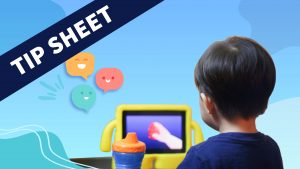
Infancy and early childhood are critical developmental windows for the acquisition of foundational language skills that affect many aspects of development over the course of one’s lifetime. The increasing availability of interactive and engaging applications and shows aimed at babies and young children may tempt many parents with promises of aiding language development by teaching words and preparing children to read. Does digital media help or hinder language development in young children? What does the research say about how parents and caregivers can foster an optimal environment for language learning?
On This Page
Tips for Parents
The Basics – How Language Develops
Parents may not know that language development starts well before the first words come out of a child’s mouth, says Kathy Hirsh-Pasek, PhD, Lefkowitz Faculty Fellow in Psychology at Temple University and Senior Fellow at the Brookings Institution. Even for a ten-week-old baby, “you hear them start to coo, and when you answer those coos in a kind of conversation, you’re starting the foundations for language,” she notes.
Infants move from interactive sound-making to being able to point at objects and listening as caregivers respond to the pointing with the word for the object. This is a form of back-and-forth conversation that is foundational to the first words emerging at about a year old, says Hirsh-Pasek.
Language Comes From Every Source
Babies and young children are soaking up information from everything around them, not just parents. “When children are learning words and getting language, they’re getting it from the people around them, they’re getting it from their toys, they’re getting it from books, and they’re also getting it from digital media,” says Sarah Kucker, PhD, Assistant Professor of Psychology at Southern Methodist University.
What’s The Evidence On Language Development and Screens?
Evidence is mixed for the link between media use and language development, says Rebecca Dore, Director of Research Crane Center for Early Childhood Research and Policy at The Ohio State University.
“Research shows that high quality educational media can promote vocabulary, and that educational media is positively associated with children’s developing language skills,” reports Dore. However, she notes this finding is true only for children around ages two and a half to three years old and up. Before this age, “younger children actually have a lot more trouble learning new information or words from media… One seminal study showed that toddlers didn’t learn new words from baby media like the Baby Einstein series, even when parents thought they did.”
Minimize Displacement of Parent-Child Interaction with Screens
An key impact of screen use on early childhood language involves the displacement of time spent on other educational activities or parent-child interactions that are important in developing this capability, says Dore. “For example, one study found that preschoolers’ TV use is related to less time spent reading books. In this case, it’s really the lower levels of book reading that we would be concerned about, not the TV use itself.”
Living with screens means balancing time on digital media with the activities that are more helpful for development, says Angie Neal, MS, Speech Language Pathologist Policy Advisor for Speech-Language Pathology and Early Literacy at the South Carolina Department of Education. “We’re wired a certain way for our interactions with other humans. We’re not necessarily wired to learn from devices. We have to make sure we’re still engaging in those activities that are helpful.”
Consider the How of Screen Use More Than How Much
Research is clear that large amounts of screen time are not recommended for optimal overall development. However, instead of counting minutes for allowed screen time per day, experts recommend looking at the context of the media use to determine limits that are appropriate for your family. “Instead of counting the minutes, count the ‘How?’ and the ‘Why are you using it?’” suggests Kucker. “Consider not just how much, but why, and when, and how the media is being used, and what it’s being used for.”
Ultimately, fostering a balanced environment that combines interactive play, social engagement, and thoughtful media use is going to best support children’s optimal language development, says Dore.
Understand the Limitations of Learning from a Tablet
Digital media makes it harder to find, encode, and remember information, says Kucker, mostly because information coming from a media source is different in nature than a real world experience. “When you’re learning on a tablet, it’s less hands-on, it’s less physical, it’s less multi-modal because it uses fewer senses.” Receiving input from multiple different senses helps solidify learning in terms of memory and encoding and cognition, she notes, “and that just can’t happen on a tablet.”
Surround Babies and Young Children with Words and Language
Babies and young children develop language from everything around them and develop the skills needed for reading early in life. Creating a language-rich environment in the first few years of life through book reading and interactive social experiences helps develop these skills. “Children need to have lots of opportunities to be exposed to words before they start reading,” says Neal. ”Everything has the potential to be a language-rich environment as long as someone is there making those connections to everything that is in the environment.”
When using digital media with young children, consider the language-rich social opportunities it might be displacing that contribute to language development, suggests Dore. ”Consider what activities the media use is taking the place of, and make sure that media is an addition to a well-rounded life instead of the primary focus.”
Beware Self-Described ‘Educational’ Content for Young Children
Any content creator or company can self-label their product or media as ‘educational’ with little oversight as to whether those claims are valid. “What is labeled as educational may not always be educational. Don’t take it at face value,” says Kucker. “If you look at YouTube and it says ‘this is educational,’ take it a step further and actually look at what the elements are” that might make it educational – or not, she suggests.
When in doubt, cross-check a media choice with a trusted reviewer, such as Common Sense Media, who can provide reviews and ratings for many popular children’s shows and apps, she suggests.
Wait to Use Media for Learning Until Children are Developmentally Ready
Applying information learned in a 2D screen environment and transferring it to the real world is extremely difficult for children, who do not develop this capability until around three years old, says Kucker. Children younger than this have what is called a “transfer deficit” in moving learning from one context to another. Learning from a tablet is difficult at that age by itself – being unable to transfer anything learned to the real world makes the information gained relatively limited, she says.
Choose High Quality Learning Content Integrated Into Narratives
It can be hard to know what experts mean when recommending that parents only let young children use “high quality” digital media. Dore suggests that the best quality educational content introduces children to new concepts and embeds information in meaningful narrative structures. “Children learn more from media when the educational content is integral to the narrative. For example, in one study, my colleagues and I collaborated with an educational app development company to create a space adventure game to teach new vocabulary. This game introduces new vocabulary words in the context of the story, and then the child has to answer questions using their knowledge of the words to move the plot line forward. And indeed, we found that children did learn new vocabulary from this game, both in an immediate test in the lab context, and after playing the game over a few weeks in their classroom.”
Higher quality narrative content also will contain examples of sentences and more complex language that can be assistive to children developing these language skills, says Dore.
Don’t Mistake Child Engagement for Learning
Visual signs of child engagement with media content is not indicative of learning, though parents may easily think engagement and learning are one and the same. A recent study showed that parent preference for children’s media was more related to their perceptions of how much they thought their child was learning, rather than how much the child was actually learning. “Parents see children engaging in a screen – it’s very flashy and colorful and exciting, and the music is fun, so children are going to look at it. But that doesn’t necessarily mean that they’re getting anything out of it,” cautions Dore.
Think about whether the child is excited about engaging with media simply because it’s flashy, novel, or attention-getting or because it’s actually providing them real learning opportunities that help with information retention, says Kucker. Is the child meaningfully engaged? Are they thinking about how or why they are interacting with it rather than just responding to cues? Just because a child is excited about something doesn’t mean it’s helping them.
Promote Learning by Reducing Distracting Content
Elements in media that distract from the educational content can actually reduce learning, says Dore. “Many e-books have sound effects or animations that are entertaining but unrelated to the story or the information we want children to learn, and these seem to detract from children’s comprehension,” she says.
However, not all sound or visual elements are unhelpful – if the elements are closely tied to the educational content, these can actually benefit children’s learning, notes Dore. “An e-book that has an animation of a person fanning themselves can help promote children’s learning of the word ‘fan.’ When making choices between different media options, it can be helpful to think about what’s going on in a show or app that is flashy and fun, and whether the engaging elements help focus children’s attention on the educational content.”
Reduce Background TV and Video Games
Research indicates that background media, like a TV or video game can significantly distract from parent-child social interaction, which can in turn affect language development, says Kucker. “When background media is on during the parent-child interaction, both the parent and the child are distracted by that, and they’re more likely to turn around to disrupt the interaction. So parents are saying less, and the things that they’re saying are also lower in quality. Their sentences may be shorter or they may not repeat the information quite as much. They may give less information around the object.” Over time, this can affect the child’s exposure to the information needed for language development.
Maximize Live Conversation Time
“Human-to-human interaction and back-and-forth social conversations are the glue that makes language development happen,” says Hirsh-Pasek. “Anything that we do that breaks that human-to-human interaction is something that’s not helping us with language and might be hurting.”
Conversation is the most efficient, effective early learning system available, agrees Neal. “At the end of every day, I hope you’ll ask yourself, ‘Have I had a conversation [with my child] today? Have I had more than one conversation today? How many turns did we take in our conversations? Or did I do all the talking? The goal is about 40 conversational turns, on average per hour.”
Parents often ask Neal about how to prepare their children for schooling and her answer is simple. “Conversation. That’s the secret. And also play.” This includes very young children who are not yet using words to communicate. Conversation is simply the “back and forth” between two people which includes facial expressions and gestures like pointing, waving, smiling, and nodding.
Conversation Tips For Helping Young Children Develop Language
Describe what you and others are doing out loud
“My first big recommendation is talk like a cooking show host like Rachel Ray or Guy Fieri,” says Neal. “As you talk about what you’re doing while you’re doing it, you’re exposing children to all of the words that describe what you’re doing. Similarly, talk like a sports announcer, or a golf announcer, or football announcer. They’re not describing what they’re doing. They’re describing what someone else is doing. So, by the same token, you can describe what the child is doing. Again, giving them the words to match their actions, that maybe they didn’t know. Do some thinking aloud, problem solving.”
Avoid asking questions with one word answers
If a one-word answer is possible to a question, kids will often limit themselves to it, says Neal. “As soon as you ask your child “How is your day?’ They’re going to respond with, ‘Fine.’ Instead, think about how we can ask those same questions in ways that will elicit more language, such as ‘Tell me three things about your day.’ When you know three things about their day, that gives more fuel for more conversation.” Ideally you can then get past just you asking questions and launch into a conversation that creates connection and understanding about how your child is thinking and feeling, she says.
Be patient when talking with kids
Some children may not answer back quickly when asked questions – it might be the case that they need that extra time to process the language and think about it before responding, says Neal. Give them waiting time to process and think before jumping in to try to answer the question for them, she suggests.
Encourage Play Time for Language Development
Play is commonly seen as important for social development, but many parents may not know that it is also critical for developing the skills needed for reading comprehension, says Neal. “We do not want to let play and conversation become replaced by time spent on screens.”
Play time does not require expensive toys or apps to provide a fruitful environment for development, says Kucker. “You can do a lot with a cardboard box,” says Kucker. “Giving an app that’s going to give [kids] the answer and not let that creativity or that live problem solving happen… a cardboard box can be even more invigorating, interactive. You can touch the box, can even eat it, and see what happens in a way that’s different from what you would do on a tablet. You don’t need a ‘rich’ environment to have a rich development.”
Meaningful and Social Interaction With Media
Media is just one source that young children utilize when developing language. For any source of language learning, “for children to actually get words into their vocabulary and get language and get grammar and sentence structure, they need lots of opportunities that are rich and interactive and social,” says Kucker. Media use that is educational and connective is much better than passive watching, she notes.
“Language isn’t just about memorizing vocabulary words, but about transferring them,” agrees Hirsh-Pasek. Dore notes a study which showed that when parents watch videos with their toddlers, the media may actually provide parents with new topics of conversation to discuss with their children and subsequent interactions. These increased interactions could potentially support children’s language development through their interaction with their parents, she says.
Other examples of interactive and social uses of media provided by experts:
-
- Characters in media or apps that speak directly to the child, mimicking real life back and forth conversations with children (Dore)
- Media that allows or requires children to touch a screen or give a verbal response (Kucker)
- Interactive video chatting for language exposure as well as bonding with older relatives (Kucker)
- Engaging and interacting with a child when co-viewing media with them (Kucker)
- Extending the characters or narratives a child is seeing on screen to role or make-believe play afterwards (Dore)
- Making connections between what’s on screen and real-world situations (Neal)
Allow Repeat Viewings of High-Quality Content
While it may seem tedious to parents when children watch the same content over and over again, children learn better from seeing the same media content repeatedly. Dore cites a study that children’s comprehension and learning from a Blue’s Clues episode kept improving when they watched the same episode every day for a week. “Allowing children to engage with the same content multiple times can actually enhance their understanding and learning,” she says.
Adjust Settings to Make Screens Less Available and Distracting
For a child that is accustomed to having access to a highly distracting and engaging device like a smartphone or tablet, it can be hard to break the attachment when attempting to scale back on screen use and increase in-person interaction time.
Using phone settings creatively to reduce the distracting features, such as changing the color screen to grayscale (just black and white), can be a helpful strategy, says Neal. “Automatically that screen is going to be less interesting and less stimulating.” Neal also suggests preparing a “busy bag” for times when a child is used to being given a device in public, like waiting in line or at a doctor’s office. “Create a little bag with Play-Doh, crayons, stickers, Hot Wheels, and other fun toys and activities,” she suggests, to give them interactive distraction that doesn’t involve a screen.
Reduce Your Own Screen Use in Front of Children
Parent or caregiver technology use in front of children is also displacing language-rich social opportunities, note many experts. “Technoference” is technology-based interference in which the parents’ own use of technology can detract from the interaction with a child. This interference can also contribute to a reduction of language-rich social interaction and conversation that help early language development.
“Put your phones down, put your phones down, put your phones down,” says Hirsh-Pasek. ”If you can just designate a few hours that are just for your kids, that would be awesome because all kids need that. Little kids feel that even when they can’t articulate it.”
Watch for Delays and Consult Professionals If Needed
You are the expert on your own child. If you feel your child is not positively responding in a way that it seems they should, and suspect a language delay, you should consult a trusted expert for further consultation and testing, says Neal. This could include your pediatrician, a local speech pathologist, or even your child’s teacher.
Considerations for Dual-Language Children
Language development for children in households that primarily speak a non-English language look a little different than one-language households. “Don’t be alarmed if your bilingual two-year-old seems like they’re delayed,” says Kucker. “Once you take into account both of the languages, they probably actually know more than an English-only kid, they’re just having to learn it twice, because there’s two words for everything. The ways that they process information might be a little bit different.” There is some evidence that bilingual children may experience benefits to executive function development by the required switching between two languages, notes Dore.
While it’s important for children to learn the language they are “loved in,” Neal urges parents to also prioritize development of enough English that they can understand general American English and attend school in English when they get to school age.
For families who want to use digital media to help teach a second language, using only an app will not be as effective as a caregiver helping the child connect the words from the screen to using that word appropriately in a real-world context, says Neal. “If you are teaching a child basic vocabulary in Spanish, but then you’re not asking them to use the word…, it’s going to be lost and it’s not going to be meaningful for the child.”



